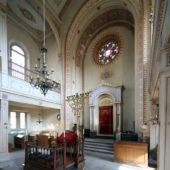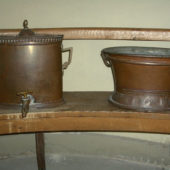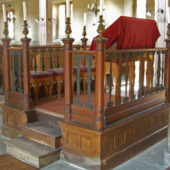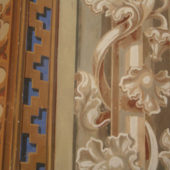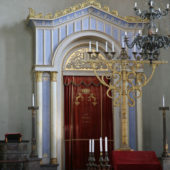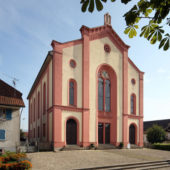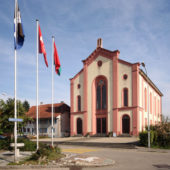Listed as a “heritage site of National significance”, the Synagogue’s clock served as Lengnau’s timekeeper for many decades.
The first area in Switzerland where Jews were allowed to live was a canton in the north, the two townships of Endingen and Lengau. These towns were situated in the district of Baden, only three miles apart. For several centuries, this formed the Swiss ghetto. Just prior to the 17th century, when the Jews were banished from the confederation, several Jewish families were brought there under special protection. However, they were forbidden to buy land, own houses or to live under the same roof as Christians.
In 1671 the gulf separating Jews from Christians widened, when a special oath was formulated for all Jews who appeared in the court of justice. Jews were heavily taxed and taken advantage of at every turn. In 1712 the Jews at Lengnau were pillaged by their neighbors. However, a charter was renewed, allowing them to continue living there, which was again renewed in 1728, 1744 and 1760, in spite of the sub-provost’s urgent demands that they be banished. However, when the charter was renewed in 1760, it was on the condition that, “they should not multiply nor allow marriages between poor persons, and that all brides from without should bring with them a dowry of at least 500 gulden,” as well as a further restriction, “that they could neither acquire houses, nor practice usury, nor buy estates, nor discount notes, without the permission of the authorities.” In 1792 a further condition was added, again forbidding Christians and Jews to live under the same roof; and this was the last time that the “Hebrews,” as the Swiss liked to call the Jews, were required to renew the charter.
Jews were not allowed to farm; therefore, many became peddlers. They had to pay a tax every time they crossed a border. If a Jew ever earned some extra money, he would be taxed back to the poverty level. The number of Jewish households was limited to 108, so many people had to wait years before they could start a family. Two-door houses are characteristic of Lengnau, one door for Jews and the other for Christians. From 1702 to 1792 the Jewish population in the area increased from 35 to 147 families. In 1799 special tolls and imposts were banned and in 1802 the poll tax was also abolished.
On September 21, 1802, during the French occupation, a riot broke out in Lengnau and Endingen. Homes of Jewish people were sacked and they lost nearly all their belongings, despite General Ney’s attempts to protect them. In 1809, a law was passed granting Jews citizenship, and the right to engage in trade and agriculture. However, they were still only allowed to settle in Lengnau and Endingen until 1846, at which time they were permitted to move to any part of the canton of Aargau. Ten years later the Jews were granted equal political rights with other Swiss citizens in that canton, and complete freedom of commerce; however, opposition from the Christians prevented this from becoming a reality.
For a long time the Swiss Jews were not permitted to bury their dead on Swiss soil, but had to take them to an island in the Rhine near Coblenz (Switzerland), called Judenaule (Jews’ Isle). It was only in the middle of the 18th century that they received permission to acquire a joint cemetery situated between Lengnau and Endingen, which has been in use since that time. In 1810 considerable funds were collected for the maintenance of communal schools which were on a par with the Christian schools. By 1850, Lengnau had a Jewish community of approximately 525 members. Famous Jews from Lengnau include film director William Wyler (The Desperate Hours, Funny Girl, Ben Hur), composer Ernest Bloch (emigrated to America in 1916), and the Guggenheim family (the first record of the Guggenheim family in Lengnau is in 1696).
In 1702, Jacob Guggenheim (a leading figure in Lengnau) stood trial for planting a vineyard without having first received permission. A year later his house was burnt down. Jacob Guggenheim led the fight against unfair taxation and gave speeches to the local government on behalf of Lengnau’s Jews, although they were not heeded. In 1818 Samuel Guggenheim courageously saved two children from a fire. He asked to refuse the reward due him but instead, to be allowed to sell his wares in the area the fire had occurred; however, his request was denied. In 1847 Simon Guggenheim and his wife Rachel and fifteen children (both Simon and Rachel had children from a prior marriage) immigrated to America.
The first Synagogue in the area was built at Lengnau in 1755, the first on Swiss soil after the general expulsion. The clock on the synagogue’s front façade has served as the city’s timekeeper for since that time. Nine years later, Endingen also built a synagogue. Originally, one rabbi served both communities.
The inspiration for Lengnau Synagogue comes from the Kassel Synagogue in design and Romanesque style, including its two-stories, three-part façade (in peach and salmon), featuring round-arch topped windows, with circular windows above them, nave and galleried aisle, and higher center bay terminating in a gable crowned by the tablets of the law. Inside the elegant prayer room, the ivory sanctuary is resplendent with arches, columns, beautiful woodwork, and exquisite Romanesque hand-painting. The barrel-vaulted ceiling is ivory with peach, gold, salmon and blue exquisitely painted decorations. The ceilings under the women’s galleries, the arch above the Aron Kodesh, women’s galleries, columns and trim all around the prayer-room also feature the Romanesque hand-painting. The bimah is situated in the center of the prayer room, encompassed by a turned wood and wrought iron balustrade, inside which sits the tivah (reader’s desk), draped in red fabric. An ornate brass menorah rises up from the balustrade to light the sanctuary. At the front of the prayer room is the Aron Kodesh, placed under a large arch inset in the wall, which has been painted in Romanesque design. It is traditional in style, with white double columns featuring cold Corinthian capitals on either side, an ornate pediment of ivory, light blue and gold, and in the center are two tablets with the Ten Commandments inscribed in Hebrew. A deep red Torah curtain with gold embroidery is drawn across the front of it. Above the Aron Kodesh sits an ornately carved hanging in blue and gold, with Hebrew scripture inscribed in gold. Above this, is a huge, beautiful round stained-glass window. Multi-armed wrought-iron chandeliers are placed throughout the prayer room. The women’s gallery is upstairs and runs along the sides and back of the sanctuary. Elegantly carved and hand-painted wood panels with railing above, separate the gallery from the main sanctuary. Elegantly decorated ivory square columns run from the ceiling, down through the women’s gallery, to the ground floor. Simply carved wood benches sit on light stone flooring.
The Synagogue is currently open every Sunday to visitors from 14:00 to 17:00. Lengnau Synagogue is listed as a Heritage Site of National Significance.

